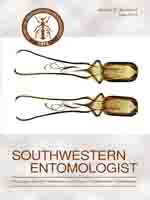Potential for widespread plantings of switchgrass, Panicum virgatum L., as a biomass feedstock prompted its evaluation as a host for economically important cereal aphids. Seedlings of four cultivars of switchgrass, ‘Kanlow’, ‘BlackweN’, ’Cave-In-Rock’, and ’Sunburst’, were evaluated as hosts for greenbug, Schizaphis graminum (Rondani), biotypes E, I, and Florida; Russian wheat aphid, Diuraphis noxia (Kurdj.), biotype 2; bird-cherry oat aphid, Rhopalosiphum padi (L.); corn leaf aphid, R. maidis (Fitch); English grain aphid, Sitobion avenae (F.); and yellow sugarcane aphid, Sipha flava (Forbes). Greenbug biotype E and Russian wheat aphid biotype 2, both economically important cereal aphids in the United States, and English grain aphid were unable to establish on any of the switchgrass cultivars. However, greenbug biotypes I and Florida, bird-cherry oat aphid, corn leaf aphid, and yellow sugarcane aphid established on all cultivars tested. The aphids which successfully established on switchgrass also reduced plant growth (number of leaves added and leaf biomass), usually by 50% or more. Interactions between greenbug biotypes and cultivars, along with observations of other aphids on switchgrass cultivars, suggested potential for developing cultivars resistant to specific aphids and biotypes.
How to translate text using browser tools
1 June 2012
Establishment and Host Effects of Cereal Aphids on Switchgrass (Panicum virgatum L.) Cultivars
John D. Burd,
Jarrad R. Prasifka,
Jeffrey D. Bradshaw
ACCESS THE FULL ARTICLE

Southwestern Entomologist
Vol. 37 • No. 2
June 2012
Vol. 37 • No. 2
June 2012




